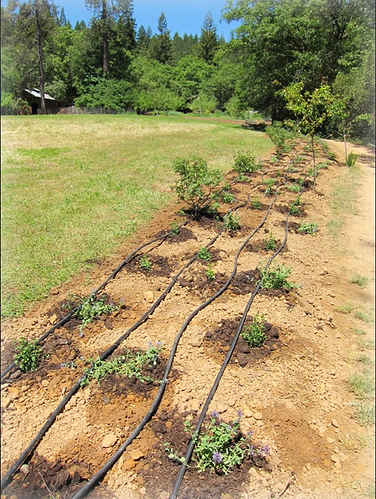Take a close look at this picture, and you can understand some of the problems with translating a single dripper rate in gallons per hour to a precipitation rate.
-
A single dripper will drip down into the soil creating a “cone shaped” area of wet dirt below the dripper. The further down the moisture flows, the greater diameter of the cone, and hence, the greater volume of soil that needs to receive moisture. So, it is not a linear relationship. This will expand outwards through capillary action to produce a “moisture circle” as shown in the picture above. Twice the watering time would not necessarily produce a watering depth twice as deep.
-
The more clay that is in the soil, the more tendency to spread the moisture laterally. Sandy soil will have a cone with a steeper angle and will not spread laterally as far.
-
AFTER the watering is done, these moist circles will continue to loose moisture to the dry areas of soil between these wet areas. So, this leaching of water away from the moist soil will affect the ability of the soil to retain the moisture it has received and continue to have this available to the plant roots.
-
So, when you are watering “spots” surrounded by dry soil, you have to adjust the frequency of watering adjust for the increase rate water is being leached out of the wet “cones” by the surrounding dry soil. What this means, compared to an automated formula such as Rachio uses, is that the “rate” of moisture decay in the soil being calculated as a function of soil type, plant type, temperature and wind speed", is going to be UNDERESTIMATED by the Rachio calculator, which is geared to calculate for a uniform rainfall situation or uniform precipatation rate where is there NO leaching of water away from the watered spots.
-
The DEGREE to which the Rachio formula will underestimate the rate of moisture decline in the wet areas is a function of how close the “wet spots” are to each other. The further apart they are, the more the water will be leached away from each wet spot because there is more dry soil all around it that continues to leach water away by capillary action.
-
Since the spacing between plants varies considerably for each user, it is not possible to have a single formula that will accomodate both the spacing between the plants, soil type and plant type, to determine a more accurate estimate of how much or how often watering has to occur to keep adequate moisture around the roots.
-
THE SOLUTION. Set up the calculation for soil type and plant type. After a watering occurs, probe the soil to determine if close to the planter if the moist area of soil is extending down deep enough to cover the presumed depth of the plant’s root. IF NOT, then you must increase the watering time. This can be most easily done by specifying a precipitation rate equivalent for the dripper that is actually SMALLER than calculated.
If you have a 1 gal per hour dripper, and find it makes a “wet spot” that is about 2 sq ft in surface area, then the approximate equivalent precipitation rate would be 1 gal per hour / 2 sq ft = 1 gal per hour / 288 sq in = 231 cu inch / 288 sq in = 0.8 in / hr precipitation rate. If this precipation rate entered into the Rachio calculation does not penetrate the soil to the entire depth of the root, then you might reduce this rate by 30%, and check the next watering cycle to see if it is penetrating deep enough.
-
The second adjust needed to to compensate for the increased leaching of water away from wet spots to the dry surrounding soil. The adjustment needed to compensate for the increase rate of moisture decline at the wet spot, is to increase the FREQUENCY of watering. The easiest way to do this is adjust the moisture slider to re-water when moisture has fallen a higher moisture level than the default setting (80%). You might set it to 50% or 40%. Now you have the irrigator watering not only longer (to increase th depth of the moisture “cone” with each watering, but also more frequently, which will compensate for the increased leaching of water from the wet circles to the dry surrounding soil.
-
After 2-3 watering cycles, and some soil probing, you should have made enough adjustments for having the moisture depth to match the depth of the plant roots, AND, the soil should be the appropriate dryness of moisture when re-watering is triggered again.
Probe the soil immediately after a watering cycle to determine if the depth is adequate. Probe the soil immediately before watering cycle to determine the soil has reached a reasonable state of dryness for re-watering to occur.
- Given the variety of plants, soil conditions, and relative spacing of the drip immitters, there will never be a perfect formula for everyone to use. However, with 2-3 watering cycle “adjustments” early on, you should arrive at a very acceptable watering depth and frequency of watering to matching the rate at which soil moisture is declining.
After these adjustments, the Rachio should be able to maintain near ideal watering with seasonal changes that affect watering needs.

